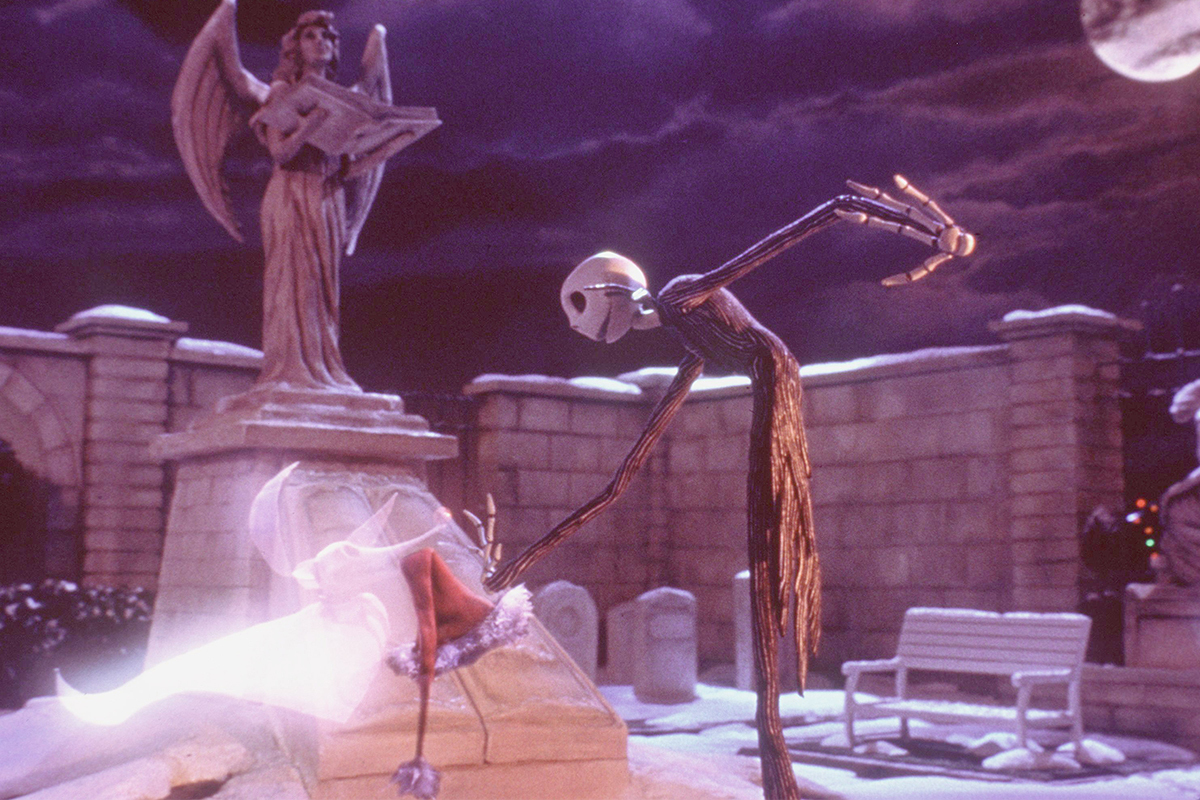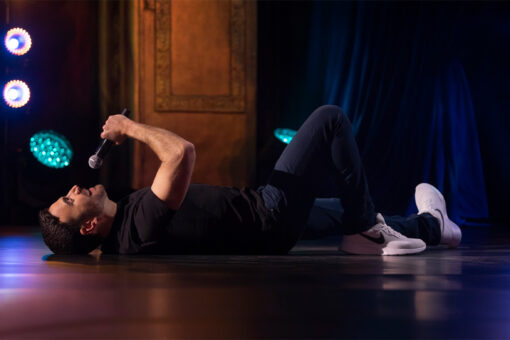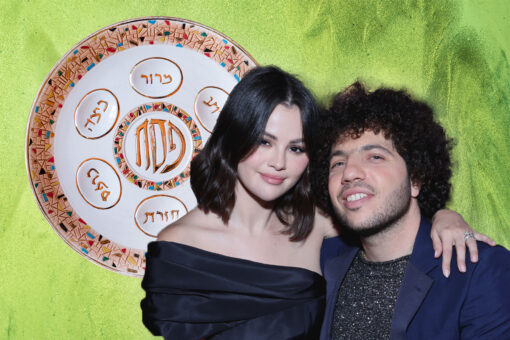The other night, a string quartet’s rendition of the score of The Nightmare Before Christmas popped up on my Spotify playlist. While listening to “Jack’s Lament,” with its mournful minor notes as Jack mopes around his hometown cemetery, I realized: The Nightmare Before Christmas is really freakin’ Jewish!
Jack Skellington, the protagonist in Tim Burton’s 1993 stop-motion animated musical, is a charismatic, lanky creative who emcees Halloween every year but has literally never heard of Christmas. Jack sings in minor keys until he visits a land of elves, lights, snow, and vibrant music in brash major chords. Enchanted, he whips his whole town into a flurry of activity to make the holiday his own.
The score is composed by Jewish national treasure Danny Elfman. (I had to Google to confirm this, and stumbled on a website called Jew or Not Jew dot com, equal parts creepy and helpful.) While having Jewish creators involved does not necessarily make the piece of art Jewish itself, Elfman’s music sounds Jewish. In an interview with Rotten Tomatoes, Elfman cites klezmer as an influence to his score for another of Burton’s cult classics, Edward Scissorhands, which came out three years before Nightmare. “The stuff [Eastern European Jewish music] that really connects with me, the stuff that really inspires me, the stuff that I feel is the soul music equivalent of classical music.” Surely, klezmer also strongly influenced the score of this film.
“Content dictates form,” asserts composer Stephen Sondheim, another nice Jewish boy. For a film to be scored like this, there must be something Jewish in the storytelling itself. And when you dig a little deeper, indeed, there is.
Jack begins the film feeling fundamentally unfulfilled by his life. During a melancholic walk around the Halloweentown cemetery, Jack laments,“Oh, somewhere deep inside of these bones/ An emptiness began to grow/ There’s something out there, far from my home/ A longing that I’ve never known.” Jews might recognize this emptiness as galut, the state of exile following the destruction of the Second Temple in 70 CE.
The pain of longing sends Jack strolling into an unknown forest and then down the rabbit hole into a totally different world: Christmasland. For the non-Jewish audience, the humor of this scene comes from seeing someone who doesn’t know what the magic of Christmas is all about. How could you not know Christmas?
As a kid, I always found it hard to believe that other children didn’t have mean grandmothers who survived the concentration camps and spoke about their experiences vividly and frequently during holiday dinners. In Christmasland, Jack tenderly observes, “The children are asleep/ But look, there’s nothing underneath/ No ghouls, no witches here to scream or scare them/ Or ensnare them, only little cozy things/ Secure inside their dreamland.” Jack is astounded that these kids aren’t enjoying the spooky scary pastimes of Halloweentown. He could even be referring to the absence of nightmares brewed from family stories of historical trauma. Nothing to ensnare them. Must be nice.
Soon, Jack brings Christmas back to Halloweentown, orders the kidnapping of “Sandy Claws,” and sets out to lead this year’s Christmas celebration. As the town assembles presents filled with monster wreaths and murderous jack-in-the-boxes, they sing the most Jewish song of the whole movie: “Making Christmas.” Doesn’t this usage strike you as… unusual? People celebrate Christmas. They get into the holiday spirit. They make things for Christmas, but they don’t make Christmas. You know who makes holidays? Frum Ashkenazi Jews! Jews “make yontif” and Jews “make Shabbos.” The phrasing, strange in English, is pretty much a direct translation from Yiddish and is used to describe all the preparation, from shopping and cooking to setting the table and lighting candles for Shabbat and holidays.
Another Halloweentown resident, Sally, the svelte if decomposing femme fatale, is the only one able to see what Jack cannot: He is trying to abandon his identity to fill the emptiness. When Jack dresses up as Sandy Claws, Sally says to him anxiously, “You don’t look like yourself, Jack.” Without understanding, he responds, “Isn’t that wonderful!” Sally is committed to the integrity of Jack’s identity, while Jack experiments on ornaments, cards, and lights with all the fervor of a yeshiva bokher furtively delving into kabbalah. Only Sally can see Jack’s plan as a detriment to his own culture and identity.
Jack’s interpretation of Christmas goes poorly, to say the least. The presents lovingly packed by the Halloweentowniks attack the little children in their homes. Jack as Imposter Santa is shot down from the sky and lands in a fiery mess in a cemetery, right back where he started this whole thing. He sings “Poor Jack” as he picks up the pieces of his true self and returns to his culture: “And for the first time since I don’t remember when/ I felt just like my old bony self again/ And I, Jack, the Pumpkin King/ That’s right! I am the Pumpkin King.” His adventure outwards has allowed him to travel inwards, not to the heart of Christmas, but to the essence of his identity and his role in his society.
With Jack’s return home, the ending of the film appears to celebrate the message: Stay in your lane. The movie models respectful cross-cultural greetings: “Happy Halloween!” Santa shouts to Jack as he flies to save Christmas. “Merry Christmas!” Jack calls back. Each holiday has its purpose. Christmas and Halloween (and, say, Rosh Hashanah) can respect each other, but never merge, which is strange for a movie that successfully blends two holidays.
In my interfaith household, we celebrate a blend of Hanukkah, secular Christmas, Solstice, and a dash of New Years. Creativity grows out of relation, experience, juxtaposition. Holiday celebrations in proximity to each other grow into new traditions, not without tension, but with the possibility of looking deeply and seeing something entirely new, yet achingly familiar. And that’s pretty Jewish.



